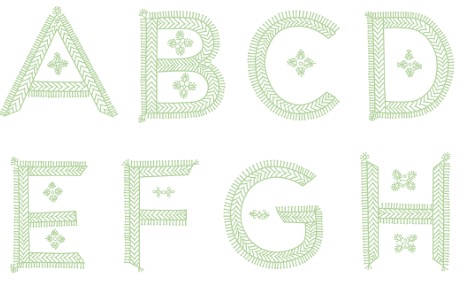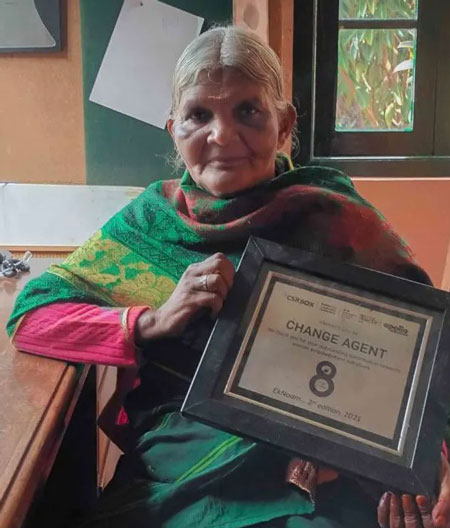
Indian tribal fashion has existed since the primordial existence of tribals who had first laid their footsteps in the subcontinent.
[…] Today, however tribal fashion in India has taken on a fresh meaning, looking towards the Western culture, with much broader and pan-Indian aspects to be proud about. People of the Indian metropolitans, with swanky shops established in every corner of streets, house tribal jewellery or tribal attires, making the rather archaic communities going great guns. Whatever is the stance of cities today, the fact remains as it is, that Indian tribal fashion has descended from the tribal ancestors, who still maintain a progeny. The hinterlands in which they perhaps reside, stay witness to umpteen innovative tribal fashion, successfully blending the ancient and the modern. […]
Flowering one’s body, empowered with rich patterns of fragrant flowers amongst many tribes of North-East India are in vogue, however with certain restrictions. Indian tribal fashion also finds proud passage in the diversified class of costumes and attires from the states and union territories that the country is dotted with. For example, men in Arunachal Pradesh, believe in keeping it simple, hence they wear lungis woven in red and black yarn, a jacket and a turban. Women from Arunachal deck themselves in a piece of cloth that wraps the body from the shoulders to the knees. This is then done again with a full-sleeved coat and a striking sash, called muhkak, tied around the waist. A Khasi man from Meghalaya is known by his dhoti (an unstitched garment for the lower part of the body), jacket and a turban. Khasi women from Meghalaya deck them with a two-piece cloth pinned on each shoulder and a shawl, called jainsem and tapmoh locally. A Garo tribes woman dons a blouse and tie and a long unstitched cloth called dakmanda, round the waist. The cloth is hand-woven, with a 6-10 inch borderline, bearing floral motifs. A Jaintia tribes woman from Meghalaya deck up in a similar manner as Garo women, with the blouse, a striped sarong, called thoh khyrwang. […]
Indian tribal fashion exists to quite a massive height in West Bengal, Bihar and parts of Orissa, with the presence of the Santhal tribe. Santhal attire basically redefines minimalism, with men donning lungi and women donning short sari without a blouse, however worn to fit their body neatly, without even going loose at any trying circumstances.
Source: Indian Tribal Fashion (Last Updated on : 28/11/2013)
URL: https://www.indianetzone.com/37/indian_tribal_fashion.htm
Date Visited: 28 February 2022
A revival of the Lambadi women’s famed embroidery has not only ensured the sustenance of the craft but also livelihoods, effectively helping households stay back in their villages, instead of migrating for labour work. […]
Elaborate mirror work and exquisite embroidery used to mark the Lambadi women’s clothes. “They learnt the craft as young girls, so that they could embroider their own clothes,” Reji told VillageSquare.in. “In the course of time, they stopped wearing their traditional clothes, and the craft also died down.”
Craft revival
Under the craft initiative of THI, a few older women who had learnt the craft from their grandmothers started teaching the younger women. […]
Source: “How the Revival of Lambadi Embroidery Is Curbing Labour Migration” by Jency Samuel, The Wire, 16 June 2019
URL: https://thewire.in/labour/how-the-revival-of-lambadi-embroidery-is-curbing-labour-migration
Date Visited: 28 February 2022
[Bold typeface added above for emphasis]

More about tattoo, fashion and design >>
“The Big-brother attitude of educators must end. The approach to tribal education has to be a two-way transaction of give and take, based on an informed appreciation of traditional tribal values and wisdom.” – Uma Ram (Professor & Head Department of English, Kakatiya PG College, Chhattisgarh) in Issues in Tribal Education in Bastar, Chhattisgarh (Folklore Foundation, Lokaratna, Volume IV 2011)

Up-to-date reports by Indian journalists and commentators
To search Indian periodicals, magazines, web portals and other sources safely, click here. To find an Indian PhD thesis on a particular tribal community, region and related issues, click here >>
Search tips
Combine the name of any particular state, language or region with that of any tribal (Adivasi) community.
Add keywords of special interest (music, poetry, dance just as health, sacred grove and biodiversity); learn about the rights of Scheduled Tribes such as the “Forest Rights Act” (FRA); and the United Nations “Declaration on the Rights of Indigenous Peoples”, “Universal Declaration of Human Rights”, “women’s rights”, or “children’s right to education”.
Ask a question that includes “tribal” or “Adivasi”, for instance: “Adivasi way of life better?” (or “tribal way of life worse?”)
Specify any particular issue or news item (biodiversity, bonded labour and human trafficking, climate change, ecology, economic development, ethnobotany, ethnomedicine, global warming, hunter-gatherers in a particular region or state, prevention of rural poverty, water access).
For official figures include “scheduled tribe ST” along with a union state or region: e.g. “Chhattisgarh ST community”, “Himalayan tribe”, “Scheduled tribe Tamil Nadu census”, “ST Kerala census”, “Particularly Vulnerable Tribal Group Jharkhand”, “PVTG Rajasthan”, “Adivasi ST Kerala”, “Adibasi ST West Bengal” etc.
In case the Google Custom Search window is not displayed here try the following: (1) toggle between “Reader” and regular viewing; (2) in your browser’s Security settings select “Enable JavaScript” | More tips >>
Note: hyperlinks and quotes are meant for fact-checking and information purposes only | Disclaimer >>
Tips for using interactive maps
Toggle to normal view (from reader view) should the interactive map not be displayed by your tablet, smartphone or pc browser
For details and hyperlinks click on the rectangular button (left on the map’s header)
Scroll and click on one of the markers for information of special interest
Explore India’s tribal cultural heritage with the help of another interactive map >>

Learn more
Crafts and visual arts | Fashion and design | Masks
eBooks, eJournals & reports | eLearning
eBook | Background guide for education
Forest dwellers in early India – myths and ecology in historical perspective
Himalayan region: Biodiversity & Water
History | Hunter-gatherers | Indus Valley | Megalithic culture | Rock art
Languages and linguistic heritage
Modernity | Revival of traditions
Tribal Research and Training Institutes with Ethnographic museums